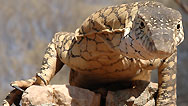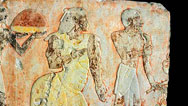Desert Biome
- Teacher Resource
- Posted 09.26.03
- NOVA
This video segment from NOVA: "A Desert Place" details the behaviors and habitats of some of the Sonoran Desert's creatures, focusing on the adaptations they use to survive in one of the most extreme environments in the world.
Permitted use:
![]() Download and Share
Download and Share


- Media Type: Video
- Running Time: 4m 58s
- Size: 8.2 MB
- Level: Grades 3-12
-
Log in to Teachers' Domain to download, share, rate, save, and match to state standards.
Source: NOVA: "A Desert Place"
Background
Precipitation in deserts, unlike other biomes, is highly irregular. In the Sonoran Desert, rain usually comes in short, sporadic clusters of rainy days three to fifteen times a year. On average, only one to six of these rainfalls is large enough to stimulate plant growth. Thus, Sonoran plants experience long periods of inactivity broken by periods of rapid growth and reproduction.
Plant production, given these extremely limited water resources, depends on the efficiency with which plants can absorb and use available water. Desert plants have evolved a wide variety of structural characteristics that limit the amount of water they lose to the atmosphere -- from dense spines on some cactuses that create shade for the plant underneath, to a waxy coating on the surfaces of leaves. In addition, many desert plants have evolved a functional strategy to limit water loss: They perform the processes of transpiration and photosynthesis separately instead of concurrently as in most plants. They do this by fixing large amounts of CO2 throughout the night, then storing it until daytime when they can use it to photosynthesize carbohydrates.
Most desert animals are what ecologists call generalists and opportunists, animals that eat whatever they find, whenever they can find it. Some small desert mammals, however, are seed-eating specialists. One study conducted in the Sonoran Desert showed that while these small herbivores (especially jackrabbits and kangaroo rats) consumed only 2 percent of all the leaves and stems produced by plants in their area in a given year, they ate 87 percent of all seeds produced. Further, the researchers found that the preferences these animals had for some varieties of seeds over others had a pronounced effect on plant populations and species composition.
Questions for Discussion
- What are the climatic conditions in the desert biome?
- Where do deserts occur in the world?
- What are some examples of desert plants and how are they adapted to their environment?
- What are some examples of animals that live in the desert and how are they adapted to their environment?
Transcript
NARRATOR: Noon in the Sonoran Desert, southern Arizona--temperature, 120 degrees Fahrenheit. In places, as little as an inch of rain falls all year.
The air has no moisture to shield against the midday heat or retain it after dark. The plants here have survived the extremes of heat and aridity because of specialized mechanisms and strategies.
The cactus is one of the most successful. They are colonists. As the desert spread, the cactus was ready to advance with it. They probably evolved in the tropics of Central America under local arid conditions. They developed the capacity to store enough water to survive a year of drought. They grow no leaves. Instead, their green skin carries out photosynthesis. It is waterproof, so the fluid stored within cannot evaporate. Spines are for more than defense. They help control temperature and water loss.
One inch high and three years old, this small bristling plant grows to be the largest living thing in this desert, the giant saguaro. It is fluted, to allow expansion as water is stored. It can grow to heights of 60 feet and to an age of 150 years.
Slow growth and great age are common survival strategies among desert plants. The mesquite tree has taproots that descend 80 feet to deposits of water that fell as rain 2,000 years ago. No known tree sends its roots deeper.
Spring migrations bring millions of birds through the Sonoran Desert. They are the least adapted to desert life, but their mobility frees them from most of the problems of land-based animals. The saguaro cactus takes the place of a tree for many woodpeckers of the desert. Gila woodpeckers raise two or three broods a yea and often make a new hole for each brood. The one they abandon will house another bird unable to make a hole of its own. His special ability accounts for the housing of 16 species of Arizona birds. Hot, arid climates are richer in lizard species than any other zone.
The lack of moisture poses few problems for lizards. They do not perspire. Their scaly hide is without pores. Although most are mute, their senses of hearing, smell and sight are extremely keen.
Of all these lizards, the desert iguana is most likely to be out at midday. He can tolerate a body temperature of 115 degrees, higher than almost any other vertebrate. So when animals that prey on iguanas have sought shade, he can be out foraging.
The Gamble's quail can get all the fluid they need from the succulent parts of plants. During the hottest part of the day, they dart from one patch of shade to another in a ceaseless search for food.
The cholla and other plants provide the antelope ground squirrel with fluid and nutrients to supplement his diet of insects and carrion. He rarely needs to drink, but if he does, even a stagnant pool of water more salty than the ocean could sustain him. No other mammal has so high a salt tolerance.
While other animals are cool underground, the squirrels are almost the only ones out at midday. They are foraging for seeds. The daytime cycles end, and the nocturnal ones wait to begin. The ground begins to radiate heat to the evening sky. The animals that hunt and forage by night are beginning to stir. A sidewinder rattlesnake tests the air for scent. Scorpions scuttle for prey. (owl hooting)
The owl chicks have been in their element all night. As dawn approaches, their activity peaks. They fan their wings to develop flight muscles. As the sun rises each day in July, it brings greater and greater heat. The cool of the night lasts only a few moments after dawn. The desert is awake.
Related Resources
-

Ingredients for Life: Water
This video segment adapted from NOVA goes on a whimsical journey in search of life forms thriving in extreme...
-

Hunting Meteorites
In this video clip, join Neil deGrasse Tyson on a trip to the Mojave Desert with meteorite hunter Rob Matson.
-

Lizard Kings
Meet the monitors, the largest, fiercest, and craftiest lizards on Earth.
-

Where Is Punt?
Despite heaps of evidence and decades of debate, scholars are not certain where or even what ancient Punt was. Why?





